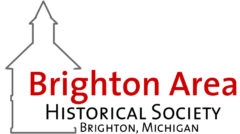Its July 4, 1871, and lots of celebration is on the schedule. Not only are Brightonites celebrating the 95th anniversary of the United States, but also the completion of the railroad to Brighton from Detroit. Farm folks from miles around join the townspeople in their merrymaking for this long awaited occasion.
For the first time the sound of the locomotive whistle and bell are heard. These signaled an end to the long trips in horse-drawn wagons to Detroit, to sell the produce grown on area farms. The proximity of this vastly improved means of transportation also meant an automatic doubling in the value of an acre.
For several years, at the intersection of the tracks and Main Street, a crossing guard sat in a small shanty ready to stop traffic at the crossing. In his spare time he cultivated a flower garden between the shanty and the water tank. Passengers on the train and pedestrians on the walk very much enjoyed the sight of a lovely garden in such an improbable setting. Since the crossing guard became well acquainted with the local residents, and with the young telegraph operators at the depot, he often played the role of cupid. It is local girls and the “depot men”.
Each locomotive whistle had its distinctive voice which was soon recognized by the citizens of the entire community. Whether it was the whistled warning at a crossing, the long, piercing, wailing sound as the engine approached the station or if the train high balled right on through the town.
Steam locomotives needed to replenish the water supply regularly. A whole cacophony of sounds emitted from this activity; the constant ringing of the bell; the hissing steam and chugging of water being injected into the boiler; the clanking of the steam water tank cover, the loud, high-pitched voices of the train crew; sharp toots signaling departure; thudding sounds of freight car couplings being engaged one at a time in a manner similar to dominoes falling; all of which resulted in disturbing the peace and quiet of a sleeping (?) neighborhood.
Cars of lumber, coal and other merchandise coming into Brighton had to be switched with cars of grain, potatoes, apples and livestock leaving. All of this activity was accomplished with whistling, bumping. Screaming of steel wheels on steel rails, and the addition of the bleating, bellowing and squealing of farm animals which had been penned in the railroad stockyards nearly all day before being loaded for shipment.
With progress came an end to steam engines which were replaced by the diesels with their air horns. “A bell and horn that are driving me crazy” supplanted the crossing guard. Subdivisions superceded productive farm lands. As with all other changes we eventually accept these as normal (ready to scream at the next change.)
Edited and condensed from memories of Wm. Pless. The second of his “Sights and Sounds of Brighton Village”
